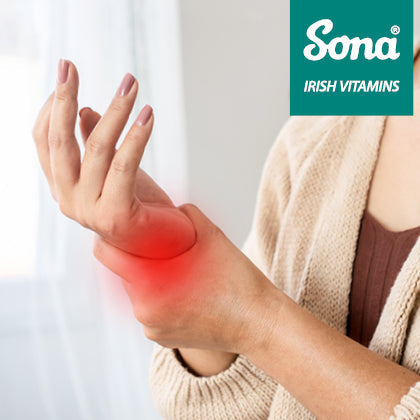
Joint pain is a common but often overlooked symptom of menopause. It can range from mild stiffness in the morning to aching knees, hips or shoulders that affect daily activities. The drop in oestrogen during menopause is a major factor, and changes in muscle strength, bone density, and lifestyle can make symptoms worse.
Understanding the link between menopause and joint pain can help you take the right steps for relief. In this article, we explore why joint pain happens during menopause, the most common triggers, and how diet, exercise and supplements can support joint health.
Why Does Menopause Cause Joint Pain?
Oestrogen’s role in joints
Oestrogen helps protect joint tissues by reducing inflammation and keeping cartilage healthy. When oestrogen levels drop during menopause, joints may become less lubricated and more prone to wear and tear. This can lead to aching joints and stiffness, especially in the morning or after long periods of rest.
Menopause vs arthritis
Joint discomfort during menopause can feel like arthritis, but the cause is different. In menopause, pain is often linked to hormonal changes, whereas arthritis is caused by joint degeneration or autoimmune conditions. However, low oestrogen may increase the risk of developing arthritis over time, so it is important to monitor symptoms.
Common areas affected
The most common areas for menopause-related joint pain are the knees, hips, hands and lower back. Some women also experience menopause, aching joints, aching legs and muscle soreness. These aches may come and go or persist, depending on hormone levels, physical activity and overall health.
How Common Is It and When Should You Be Concerned?
Joint pain affects more than half of women during the menopausal transition. Research from the National Institutes of Health shows that hormonal changes, particularly the drop in oestrogen, can significantly impact joint comfort and mobility. These aches are most common in the knees, hips and small joints of the hands, but some women also notice stiffness in the shoulders and lower back.
While occasional discomfort can be a normal part of this stage, persistent or severe pain should not be ignored. According to the NHS, constant joint pain, worsening, or accompanied by swelling, redness or loss of movement may be linked to other conditions such as arthritis or osteoporosis.
If you experience these symptoms, it is essential to consult your doctor. A healthcare professional can help rule out underlying causes and recommend treatment options, from lifestyle changes to targeted therapies, to improve your joint health and overall well-being.
Daily Tips to Manage Joint Pain Naturally
Finding the right joint pain remedy during menopause often starts with small but consistent changes in daily habits. While medication and supplements can help, many women notice real benefits from natural lifestyle adjustments. Here are some effective, evidence-backed approaches you can try.
Keep moving
Low-impact activities like walking, swimming, yoga and cycling help keep joints flexible and muscles strong. Regular movement supports circulation and reduces stiffness without putting excess strain on your joints, according to the Mayo Clinic. Aim for at least 30 minutes most days of the week.
Choose a joint-friendly rest
Rest is important, but staying completely inactive can make stiffness worse. If you spend long periods sitting, take short breaks to stretch and walk. The Arthritis Foundation recommends gentle stretching before bed to ease discomfort and maintain flexibility.
Manage your weight
Excess body weight increases pressure on the hips, knees and lower back. Maintaining a healthy weight can reduce strain and help protect joint structures over time. Even a small reduction in weight can make a noticeable difference in muscle joint pain.
Relax and reduce stress
Stress can make pain feel more intense. Relaxation practices such as mindfulness, breathing exercises or light stretching can help ease tension in both the mind and body. Scheduling moments of calm throughout your day can support overall well-being.
Best Supplements for Menopause Joint Pain
Lifestyle changes can make a big difference to joint comfort, but many women also benefit from targeted nutritional support. Certain joint supplements may help protect cartilage, ease inflammation, and improve flexibility, making them a valuable part of a joint pain remedy during menopause.
JointPlan : All-in-One Joint Support
JointPlan combines glucosamine, chondroitin, collagen, and vitamin C to help maintain cartilage structure and reduce stiffness. These nutrients work together to support joint mobility and protect connective tissue. For women in menopause, this can be especially beneficial, as collagen production naturally declines with age, making joints more vulnerable to wear and tear. Sona JointPlan offers this all-in-one support in a convenient daily formula.
Glucosamine: Support for Cartilage and Joint Comfort
Glucosamine is one of the most researched natural ways to relieve joint pain. It plays a key role in maintaining the cushioning effect of cartilage, helping joints move smoothly. Supplementation may be particularly useful for menopausal women experiencing aching joints and reduced flexibility. For an option designed for everyday use, Sona Glucosamine provides a high-quality source to help keep joints healthy.
Evening Primrose Oil: Supporting Hormonal Balance and Joint Comfort
Rich in gamma-linolenic acid (GLA), evening primrose oil may help reduce inflammation and morning stiffness. It is often used to support hormonal balance, which in turn can ease menopause-related joint pain. Regular use may improve comfort in areas like the knees, hips, and hands. Sona Evening Primrose Oil offers a concentrated source of GLA for daily support.
Turmeric: A Natural Anti-Inflammatory
Turmeric contains curcumin, a plant compound known for its anti-inflammatory properties. It may help reduce swelling and discomfort while supporting long-term joint health. For those looking for natural remedies for joint pain, Sona Turmeric Max can be a valuable addition alongside a healthy diet and active lifestyle.
While supplements can offer effective support, they work best when combined with balanced nutrition, regular low-impact exercise, and other healthy habits. These approaches can help keep you flexible, ease stiffness, and protect cartilage as the years go by. Add in some joint-friendly movement and a nutrient-rich diet, and you may notice real changes. Many women find this helps with muscle joint pain and menopause-related aching legs, making it easier to move and feel better day to day. Always speak to a healthcare professional before starting a new supplement, especially if you are on medication or have a medical condition.
Final Thoughts
Menopause can bring new challenges, but joint pain does not have to hold you back, especially when you combine the right menopause joint supplements with lifestyle changes. This approach can help you stay active, mobile, and comfortable well into the future.
References;
Pan, W.Y., et al. (2016). Effect of turmeric and curcumin on inflammation and arthritis. Journal of Medicinal Food, 19(8), 717–729. https://doi.org/10.1089/jmf.2016.3705
Martin, K.A., & Manson, J.E. (2008). Approach to the patient with menopausal symptoms. The Journal of Clinical Endocrinology & Metabolism, 93(12), 4567–4575. https://academic.oup.com/jcem/article/93/12/4567/2596745
Arthritis Foundation. Flexibility exercises. https://www.arthritis.org/health-wellness
Mayo Clinic. Menopause – Symptoms and causes. https://www.mayoclinic.org/healthy-lifestyle/adult-health/in-depth/menopause/art-20046020
National Institutes of Health. The relationship between menopause and joint pain. https://pubmed.ncbi.nlm.nih.gov/20537472/
